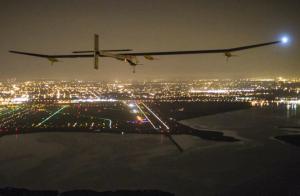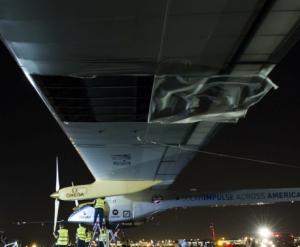Last weekend, the flight plan for the final leg of the Solar Impulse's cross country flight had it silently floating by the Statue of Liberty before touching down early Sunday in New York. But a tear on the left wing discovered on Saturday forced the flight team to abort the time-consuming fly-by and head directly to JFK. Once out of the cockpit, pilot Andre Borschberg celebrated the plane's milestone. "It was a huge success for renewable energy," Borschberg said while standing on the runway at JFK. "The only thing that failed was a piece of fabric."

A unique design
During the journey, the aircraft soared to 30,000 feet while creeping along at a top speed of 45 mph. While most of the craft's 11,000 solar cells are packed on huge Airbus-length wings, Solar Impulse weighs only about the same as a small car, powered by what is essentially a small motorized scooter. (A short video about the plane's chemistry.) The craft's batteries are the main weight and design constraint. Still very heavy, they require drastic weight reduction for the rest of the plane. The lithium polymer battery weighs 400kg, or more than 1/4 of the total mass of the plane. In the video below, highlights from the plane's cross-country voyage.
Next goal: around the world
Lessons learned from the first plane are already being incorporated in the much more ambitious second, which is scheduled to fly around the world. A more spacious cockpit will enable the pilot to fully recline during flights lasting from 4 to 6 days; it will have an increased payload; its electrical circuitry will be isolated to enable flights in the rain; and system redundancy will improve reliability. While today's plane used existing technologies, the second plane has required the development of new materials and construction methods. Solvay has invented electrolytes that allow the energy density of the batteries to be increased; Bayer Material Sciences is allowing the project to make use of its nanotechnologies; and D?cision is using carbon fibers that are lighter in weight than any previously seen. SunPower will continue as the solar cell supplier, after having provided its high-efficiency Maxeon solar cells to the 1st plane, which powers four electric motors and charges the batteries during the day, enabling the craft to fly at night. "SunPower is definitely the leader in development of high-efficiency solar technologies. It provides Solar Impulse with the optimum solutions in terms of performance and lightness for our revolutionary airplanes," explained Andre Borschberg, Co-founder & CEO of Solar Impulse.



